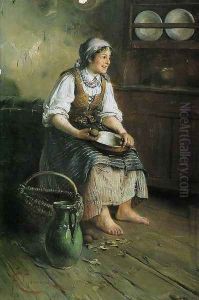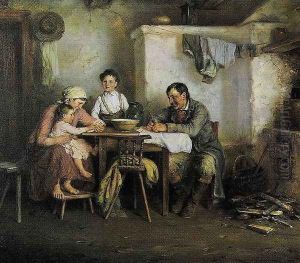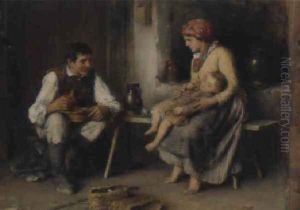Franciszek Ejsmond Paintings
Franciszek Ejsmond was a Polish painter, art critic, and educator, born on December 15, 1859, in Vilnius, which at the time was part of the Russian Empire and is now the capital of Lithuania. His artistic journey began at the Drawing School in Vilnius, after which he continued his education at the St. Petersburg Academy of Arts, where he studied from 1879 to 1886. Ejsmond's academic training in St. Petersburg laid the foundation for his technical skills and classical approach to painting.
During his time at the Academy, Ejsmond was awarded a scholarship that allowed him to travel and study in Western Europe. He spent considerable time in Germany, France, and Italy, which were central to broadening his artistic horizons and exposing him to various styles and movements, such as Impressionism. Nevertheless, Ejsmond remained mostly loyal to the academic style of painting, creating works that were characterized by meticulous detail, clarity, and a controlled color palette.
Upon returning to Poland, Ejsmond became an active participant in the Polish art scene. He was involved in the Society for the Encouragement of Fine Arts (Towarzystwo Zachęty Sztuk Pięknych) and contributed to the development of young Polish artists as a professor at the School of Fine Arts in Warsaw, where he taught from 1897 to 1929. His teaching career had a significant impact on the next generation of Polish artists.
Ejsmond's own artistic work was primarily focused on genre scenes, portraits, and landscapes. His genre scenes often depicted the life of the Polish gentry and the rural population, reflecting his interest in the social and cultural aspects of his homeland. His landscapes, on the other hand, were frequently inspired by the scenery of the Polish countryside and the Tatra Mountains, capturing the unique atmosphere and light of these regions.
Throughout his career, Ejsmond exhibited his works in various cities across Europe, gaining recognition and accolades for his contributions to art. He was not only a painter but also an art critic, writing about art in various Polish periodicals, thus influencing public opinion and taste.
Franciszek Ejsmond's death occurred on September 10, 1931, in Warsaw, Poland. His legacy is preserved in his paintings, which can be found in museums and collections in Poland and abroad, and in the generations of students he taught, who carried forward his academic principles and appreciation for traditional painting techniques.


